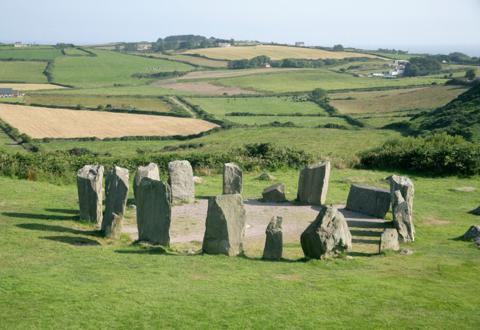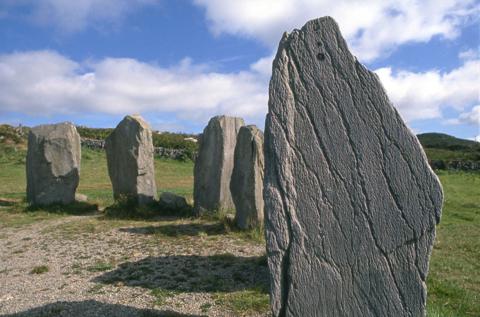
Drombeg stone circle is dramatically situated on a rocky terrace with sweeping views over farmland to the Atlantic Ocean. Drombeg is perhaps the finest example of a distinctive series of stone circles found in Cork and Kerry. Stone circles were places of ritual and ceremony in the later Bronze Age period (c. 1500 BC - 600 BC) and were usually associated with human burial. Also at the site is a fulacht fiadh or prehistoric cooking site.

Stone circle
At Drombeg the seventeen stones are symmetrically arranged so that one of the stones (the axial stone) is set on its side and placed directly opposite a pair of tall stone (the portal stones) that form the entrance to the circle. The stones reduce in height from the portals to the axial stone which has two shallow cup marks carved on its upper surface. In common with many stone circles in the region, the axis of the circle (i.e. the line extending through the entrance across the top of the axial stone) is orientated north-east / south-west. At the winter solstice (21st December) the sun sets at a point on the horizon aligned with this axis. This marks of the shortest day of the year in Ireland. Excavations undertaken in 1957 revealed a central pit that contained a pottery vessel covering the cremated remains of a youth. Radiocarbon dating has placed the burial in the period c. 1100-800 BC.

Fulacht fiadh
Very close to the stone circle are the remains of two hut sites and a fulacht fiadh (ancient cooking place). The fulacht fiadh consists of a stone-lined trough with a nearby hearth and well. Water in the trough would have been heated by rolling in stones heated by fire in the hearth. Experiments have shown that in about 18 minutes, 70 gallons (318 litres) of cold water could be brought to the boil in this way. Meat was then cooked in the water, which remained sufficiently hot for almost 3 hours. Alternative suggested uses for fulachtaí fia are ritual bathing, as well as industrial activities such as dyeing and even brewing.
To locate Drombeg Stone Circle and fulacht fiadh on the Historic Environment map viewer please click here
